|
Data File Updated: Sunday, June 18, 2017 About the Weapon ProfilesThe profile tables below list weapon damage as a function of range measured in megameters (Mm), or thousands of kilometers. One "point" of damage is an abstracted value of destructive energy sufficient to destroy one ship component or a small target such as a missile. The "RoF" entry represents the rate of fire of the weapon, expressed as the number of times it can fire per minute. Other special features of the weapon are noted in the "Notes" column and described in the accompanying text. While such damage information is admittedly of limited use without an accompanying Ship Systems entry [which I will eventually add, time permitting], at least it's possible to compare weapons and get a sense of effective ranges. For information on the ship classes and which and how many weapons they carry, see the fleet lists for the Loroi, Umiak and Terrans. Beam WeaponsThe primary offensive weapons in Outsider are various forms of beam weapons. The maximum range at which you can normally expect to score a hit with a beam weapon on a maneuvering target is about 1 Light Second (approx. 300,000 km, or 300 Mm); this is roughly Earth-Moon distance (see image below). Any farther away than that, and the delay between the arrival of your targeting radar pulse and your beam reaching the target becomes such that the target may have changed vector. The Loroi heavy beam weapons such as the pulse cannon and superheavy blaster can cause damage out to this distance; Umiak heavy beam weapons can score a hit at this distance, but need to be closer to do significant damage.
Lasers
Laser AutocannonA leftover from the early days of the Loroi Empire, the laser was once a medium-range multipurpose weapon, but with technological advancements, the Loroi Laser Autocannon has become miniaturized and fast-firing, and is used for point defense in lieu of a small version of the blaster. The laser can strike targets at greater range than most other point-defense weapons, and has some ability to penetrate shields and atmosphere. Shipboard Laser Autocannon are usually mounted in a ball turret with three barrels that alternate fire for more or less continuous pulses. Smaller versions of the Autocannon are also used on many Loroi fighters. Terran LasersHumanity is only just developing viable anti-ship particle beam weapons, so lasers are still the primary beam armament of most Terran warships. Ground Point Defense StationsLasers will be reduced in power when firing through atmosphere, but they are still viable enough to be used in ground-based weapon mounts. The limited range of lasers (especially through atmosphere) mean that these weapons are mainly useful for point defense against munitions or small craft, but they can offer some threat to warships in comparatively close orbit. Unless the ground base is located on an airless moon or other small body, laser weaponry is really the only viable beam option. (See below for more on missile weaponry.) Laser Beam Damage by Weapon Type and Distance
*SP = Screen Piercing: effectiveness of defensive screens is reduced by the indicated fraction against this weapon. Particle Beams
The Delrias and their Morat cousins both have extensive expertise in perfecting long-range particle beams, and the designs used by both the Loroi and Umiak are based on these examples. The Morat version (which the Umiak use on some of their ships) does more basic damage, but the Delrias version (modified and widely used by the Loroi) is better at penetrating armor. Terran Mjolnir CannonThe "Mjolnir" is a modular upgrade to the America-class heavy cruisers, which replaces the forward shuttle bay with a large single-barrel particle beam cannon. The TCA had been experimenting with particle beams prior to alien contact and planning long-term upgrade options; after contact in 2158 they put those plans into effect as rapidly as possible. By the time the Alien Contact Mission scouts left Esperanza in August of 2160, two cruisers (America and Afrika) had already completed the upgrade. The Mjolnir has improved damage and armor penetration capabilities compared with the heavy laser; the drawbacks are reduced range and the limited field of fire of the spinal mount. Because it is an experimental weapon and must draw on ship power systems that were not designed to accommodate it, the Mjolnir has a limited rate of fire and suffers from frequent downtime. Particle Beam Damage by Weapon Type and Distance
*AP = Armor Piercing: effectiveness of armor is reduced by the indicated fraction against this weapon.Plasma Weapons
Umiak Plasma FocusThe standard SR version of the plasma focus armed Umiak vessels well before the start of the Great War. The remarkable sophistication of the weapon (which the Loroi have been unable to directly copy) leads Loroi intelligence to believe that the Umiak did not invent it themselves, but rather obtained the design from a third party, perhaps one of their unknown client states. Though devastating at close range, the SR focus has significant range limitations, and so several years into the war the Umiak introduced the MR version, which increased effective range at the expense of lower maximum damage. Historian Plasma ArrayThe Historian version of the plasma focus uses a different focusing mechanism than the Umiak version, and has significantly longer range. It can also be fired in multiple different modes: a normal mode effective over long range, an overloaded mode for maximum damage at closer ranges, and in a pulsed mode for point-defense. Loroi Pulse CannonWhen the Historians gave the Loroi the plans for a dumbed-down version of their plasma focus, it was still too advanced for the Loroi to copy exactly; they could only get it to work in short bursts. The result was the Loroi pulse cannon, which sends multiple pulses of plasma down the carrier wave to the target; it doesn't do as much damage as the Umiak plasma focus, and the damage is highly variable, but it can do significant damage at much longer ranges. Currently the premier Loroi heavy weapon, the pulse cannon is effective both at overloading defensive screens and at damaging armor. Plasma Beam Damage by Weapon Type and Distance
*AA = Armor Ablating: target armor receives additional damage on penetration. SS = Screen Splash: defensive screen generators receive additional damage if overloaded. Wave-Loom DeviceThis weapon consists of two long rails and two sets of accumulators, most often housed in the forward prongs of a Loroi vessel. It works on a similar principle to the Pulse Cannon, using a carrier wave to conduct plasma to the target, except on a much larger scale, and the plasma being used is composed of exotic particles that can interact to generate a "quantum loom" effect that can disrupt matter in the vicinity of the target. In order to fire, the Wave-Loom must be charged by diverting main power over several minutes, in the same way (and often using the same accumulators) as charging the jump drive. The advantages of the weapon are long range and the secondary area-of-effect damage which easily penetrates armor. The disadvantages are the extreme cost, size, power requirements, maintenance requirements, slow charging time, limited accuracy (as the entire ship must be pointed at the target), and overheating that may result from repeated firings. Vortex Assault System
Damage potential is dependent on how much power is accumulated in the weapon before firing. Each minute spent diverting full power to the accumulators is counted as one "charge;" Tempest's accumulators can hold a maximum of 8 charges, but the weapon can fire with as few as 1. Charges may be held in the accumulators without firing, but doing so with more than 6 charges may cause overloads or overheating over time. When fired, the Wave-Loom releases all stored charges. Multiple firings of the Wave Loom can play havoc with the energy transmission and cooling systems of the firing ship. Tempest can fire the weapon with 6 charges only twice before saturating her heat system (any single firing with more than 6 will do it in one shot); subsequent firings of more than 3 charges without time to cool the system risks damage to the ship. Possible failures include overload or damage to the Wave-Loom device itself, heat system overload (in which the main batteries can no longer be fired for a time), or even complete power system overload (in which main engine power is not available for a time). Wave-Loom Damage by Type and Distance
*IA = Ignores Armor. SS = Screen Splash: defensive screen generators receive additional damage if overloaded. Missile WeaponsBecause of the speeds and distances in Outsider, missile weapons play a secondary role in combat to beams. Whether carrying a high-yield payload (such as antimatter) or relying on high velocity for kinetic kill, projectiles can do a terrific amount of damage, but the trouble is getting them across large distances in a timely manner to engage very fast-accelerating targets that have effective beam-weapon defenses. With an acceleration of 30g, it takes a missile more than 23 minutes from a standing start to cross the 1 light second of a beam weapon's effective range; that's a lot of time to be intercepted. The higher the acceleration of a missile, the more quickly it will burn its fuel. The larger you make a missile to give it more fuel, the more expensive and economically impractical it becomes to use in large numbers. The two main strategies are either to use them as short-range, high-acceleration point defense weapons, or as larger, more expensive longer range high-endurance anti-ship weapons which are referred to as "torpedoes." Anti-Missile Missiles
The standard Loroi ship-mounted launcher is a cylindrical turret that contains 36 rounds (typically with access to at least an equal number of reloads via internal magazine) with either 3 or 6 launching tubes, each of which is capable of launching 6 missiles per minute. Some defense-oriented vessels (such as the Rapier-class) use larger 20-tube box launchers. Loroi fighters typically carry the AMM-250 in 3-missile or 6-missile hardpoint modules, from which any or all of the missiles can be fired simultaneously. Fighters can theoretically launch AMM's from close enough range and with high enough starting velocity to do significant damage to larger vessels, but in the current war with the Umiak, the Loroi fighters have had survivability problems in proximity to large numbers of Umiak vessels, and so AMM's are most often used to engage torpedoes and occasionally gunboats. AMM's can also be deployed by blister torpedoes (see below). The Umiak version of the AMM (the "Gimlet") is smaller and used mainly for close-in point defense. Missile Characterstics by Type
*Maximum damage assuming a terminal velocity based only on the weapon's own acceleration. IS = Ignores Defensive Screens. Torpedoes
Because torpedoes have such high damage potential but are relatively easy to intercept, they are often deployed as a defensive tactic, to draw enemy beam fire away from the launching vessel. The Loroi use modest numbers of short- or medium-range torpedoes in this manner to help survive close-range encounters with Umiak vessels. The Umiak use large numbers of longer-ranged torpedoes (often in conjunction with gunboats) to help screen their entire force while trying to close range with the Loroi; only the Umiak have the industrial might to be able to afford the expense of this tactic. Torpedoes can be deployed from dedicated launch tubes, from internal or external ordnance racks, or directly out of an open hangar bay. In some cases the launch system may use some kind of catapult or booster to quickly propel the torpedo to a safe distance at which it can light its main drive. Blisters and Submunitions
The largest Loroi version, the DX Armored Blister, is larger than a shuttle, and can carry 6 MR or 12 SR torpedoes, 40 USR "Tolot" torpedoes, 40 Type-A warheads, or 60 AMM-250 rounds. Due to its high cost and space requirements, the DX is always in limited supply, but it is much coveted among Loroi captains. Torpedo Characterstics by Type
*Fuel Endurance at maximum thrust. XM = Has multiple drive nozzles for additional maneuverability. Mass Drivers
Mass Driver Damage by Type
*Maximum damage assuming a terminal velocity equal to muzzle velocity. IS = Ignores Defensive Screens. BombsA minimally-guided package containing a warhead, which is usually just a container for Type-A fuel (taimat), usually intended for attacks against planetside targets or space-borne targets that are unable to maneuver. It can generate an explosion equivalent to a torpedo carrying the same amount of fuel, but depends on the launcher (ship, fighter, or blister) for velocity and so represents the cheapest possible method of delivering such a payload. The standard Loroi warhead is the size and weight of a USR torpedo, but has the yield of a medium-range torpedo and is much cheaper than either. Small Craft
Small craft are typically housed and serviced in hangar bays. Most ships will have at least one small hangar bay to accommodate utility shuttles. The launch and recovery rates of a hangar bay will depend on the configuration of the individual vessel. Dedicated carrier vessels will often have more than one bay, and/or specialized infrastructure to allow rapid deployment and recovery of small craft. ShuttlesMost vessels larger than 100m in length will have at least one utility shuttle to ferry supplies and personnel between the ship and orbital or ground ports. They vary in size and capability, from small maintenance craft to larger atmospheric landing craft. Shuttles are frequently unarmed, but some are highly configurable, able to be outfitted to the needs of the moment. Larger, armed shuttles can be used to enable marine to board a crippled ship, or can transport troops from orbit to the surface of a planet. Most shuttles will have modest engines, as without inertial dampers there will a limit to how much acceleration stress their cargo or passengers can withstand. A few larger shuttles, such as the Loroi "Highland," have enough power to operate their own inertial dampers, and so can accelerate at much higher rates without damage or discomfort to their passengers and crew; however, these are large, expensive craft. Fighters
GunboatsThough often referred to as "small craft," the gunboats employed by the Umiak straddle the line between small craft and full-fledged ships, as they are the size of a small starship and usually have inertial dampers and occasionally even jump drives, but are still mostly dependent on motherships for operation. Gunboats tend to have limited supplies and minimal crew accommodations, and so are towed into combat by the mother vessel and launched only shortly before the engagement. Most gunboats are too large to be carried internally, and so are usually carried and serviced using special tow linkages. Atmospheric OperationSome small craft are intended for use only in the vacuum of space, while some are designed for atmospheric and trans-atmospheric use. In the table below, craft are graded on their degree of atmospheric operating capacity, from A (fully streamlined and maneuverable in atmosphere, able to takeoff and land in atmosphere) to F (no design capability to operate in atmosphere). Small Craft Characteristics by Type
*Maximum acceleration may be reduced when carrying unprotected passengers or when operating in atmosphere. Q&AHow much of a ship's power must be diverted to weapons? Given the fantastic energies required to push these starships along at 30g, I think that the energy requirements of most conventional beam weapons are going to pale by comparison, and so I'm assuming that as long as a ship has main power, a proper warship can probably accelerate at the maximum capacity of its drives and still have energy to fire all of its available weapons. The rate of fire of most beam weapons is going to be limited mostly by heat management and mechanical issues, rather than available power, and will probably be once per minute or less for most heavy beam weapons. I'm skeptical about the feasibility of accurately focusing a beam from turret aboard an accelerating, maneuvering ship against a target 300,000 km away. I would think you'd have to use a fixed spinal mount, and point the whole ship at the target. Even today's mechanical telescope tracking mechanisms are more accurate than what would be required to successfully paint a target at the distances we're talking about. A large turret on a half-million ton starship seems like a pretty stable platform. But in any case, if that accuracy seems hard to achieve for a turret mounted weapon, I don't think pointing the whole half-million tons of starship to that same accuracy is going to be any easier. With nukes today, you have to have a lot of tech to make them. But in space, just plain kinetics can cause a lot of damage. So even the most primitive space faring culture can launch a planet-killing attack. Of course, the more effective your engines, the easier that is to do. Yes, destroying the surface of a planet is not very hard, even with our technology today. Kinetic weapons (such as the AMM) will be lethal when launched from high velocity, and various kinds of bombs with thermonuclear or antimatter warheads can easily cause widespread devastation, and either of these kinds of attacks are very difficult to defend against with ground defenses, but can be launched by even the smallest escort warship. However, in this conflict inhabited planets are rarely on your front lines, and getting access to such planets past the front lines guarded by the enemy's starships is very hard. It's the battle trying to get past the enemy fleet that you need to worry about; once you win that and achieve space superiority in a system, the enemy planet is at your mercy. What is the energy of one "damage point"? It's abstracted to give myself some wiggle room, but it would be measured in gigajoules. See also: Loroi Warship Classes, Umiak Warship Classes, Terran Warship Classes |
![]()
1
2
3
4
5
6
7
8
9
10
11
12
13
14
15
16
17
![]()
18
19
20
21
22
23
24
25
26
27
28
29
30
31
32
33
34
35
36
37
38
39
40
41
42
43
44
45
46
47
48
49
50
51
52
53
54
55
56
57
58
59
60
61
62
63
64
65
66
67
68
69
70
71
72
73
74
75
76
77
78
79-80
81
82
83
84
85
86
87
88
89
90
91
![]()
92
93
94
95
96
97
98
99
100
101
102
103
104
105
106
107
108
109
110
111
112
113
114
115
116
117
118
119
120
121
122
123
124
125
126
127
128
129
130
131
132
133
134
135
136
137
138
139
140
141
142
143
144
145
146
147
148
149
150
151
152
153
154
155
156
157
158
159
160
161
162
163
164
165
166
167
168
169
170
171
172
173
174
175
176
177
178
179
180
181
182
183
184
185
186
187
188
189
190
191
192
193
194
195
196
197
198
199
![]()
200
201
202
203
204
205
206
207
208
209
210
211
212
213
214
215
216
217
218
219
220
221
222
223
224
225
226


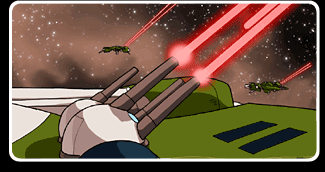 The laser is a tight beam of
coherent photons that can be projected over significant distances.
It's the basic anti-ship beam weapon of those civilizations in
their early starfaring stage (including Humanity) and is still
used for specialty purposes such as point-defense and
atmospheric operation by even the more advanced fleets. The two main
drawbacks are that the beam loses intensity over distance (and
light is hard to "corral" back into a tighter beam), and
that lasers are not very effective against ablative or
reflective armor specifically designed to protect against them.
On the plus side, lasers of appropriate frequency can operate
through atmosphere with limited loss of power, and photons are
effective at penetrating electromagnetic defensive screens,
making lasers screen-piercing weapons.
The laser is a tight beam of
coherent photons that can be projected over significant distances.
It's the basic anti-ship beam weapon of those civilizations in
their early starfaring stage (including Humanity) and is still
used for specialty purposes such as point-defense and
atmospheric operation by even the more advanced fleets. The two main
drawbacks are that the beam loses intensity over distance (and
light is hard to "corral" back into a tighter beam), and
that lasers are not very effective against ablative or
reflective armor specifically designed to protect against them.
On the plus side, lasers of appropriate frequency can operate
through atmosphere with limited loss of power, and photons are
effective at penetrating electromagnetic defensive screens,
making lasers screen-piercing weapons. 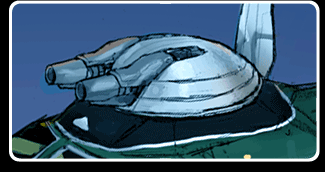 The particle beam (or
"blaster") is a beam of charged or
neutral particles that is better at penetrating armor
than a laser. The challenge is keeping the beam focused
over long distances;
particles (especially charged) are likely to spread faster than
the photons in a laser. Neutral particle beams were probably the first
version of the blaster in service; these would have been
relatively short-ranged. At higher tech levels, I presume ways
are found to substantially extend blaster range; I imagine a
sort of particle helix, where opposed "braids" of
particles of opposite charge loop around each other, keeping the
beam focused for extended distances. Assuming that this sort of
configuration could extend effective ranges out to about half a
light-second, the blaster would replace the laser as the
standard anti-ship beam weapon. The main drawback of charged particle
beams is that they are probably easily deflected by
electromagnetic screens. Particle beams also have limited effectiveness when fired through
atmosphere.
The particle beam (or
"blaster") is a beam of charged or
neutral particles that is better at penetrating armor
than a laser. The challenge is keeping the beam focused
over long distances;
particles (especially charged) are likely to spread faster than
the photons in a laser. Neutral particle beams were probably the first
version of the blaster in service; these would have been
relatively short-ranged. At higher tech levels, I presume ways
are found to substantially extend blaster range; I imagine a
sort of particle helix, where opposed "braids" of
particles of opposite charge loop around each other, keeping the
beam focused for extended distances. Assuming that this sort of
configuration could extend effective ranges out to about half a
light-second, the blaster would replace the laser as the
standard anti-ship beam weapon. The main drawback of charged particle
beams is that they are probably easily deflected by
electromagnetic screens. Particle beams also have limited effectiveness when fired through
atmosphere.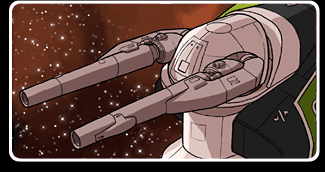 The
plasma cannon (or plasma "focus") conducts a stream of
fusion-temperature plasma to the target at high speed. Because
the net charge of the plasma would very quickly cause the beam
to lose cohesion, a "carrier wave" is required to restrict the
plasma into a tight beam over distance. Generation of this wave
requires direct manipulation of force, and so is at the limits
of the technical capabilities of the major combatants -- only the
Umiak and Historians have really mastered this technique. The
advantages of the plasma focus are very high power and good
armor penetration/ablation. The disadvantage is limited range,
and like particle beams the plasma usually has a net charge and
so will be significantly affected by defensive screens; however,
plasma from the heaviest of these weapons can cause a splash
effect that may overload screens even when successfully
deflected. Plasma weapons are not effective at all firing from within or
through atmosphere.
The
plasma cannon (or plasma "focus") conducts a stream of
fusion-temperature plasma to the target at high speed. Because
the net charge of the plasma would very quickly cause the beam
to lose cohesion, a "carrier wave" is required to restrict the
plasma into a tight beam over distance. Generation of this wave
requires direct manipulation of force, and so is at the limits
of the technical capabilities of the major combatants -- only the
Umiak and Historians have really mastered this technique. The
advantages of the plasma focus are very high power and good
armor penetration/ablation. The disadvantage is limited range,
and like particle beams the plasma usually has a net charge and
so will be significantly affected by defensive screens; however,
plasma from the heaviest of these weapons can cause a splash
effect that may overload screens even when successfully
deflected. Plasma weapons are not effective at all firing from within or
through atmosphere.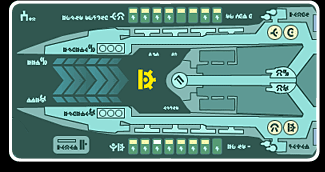 VAS is
the version of the Wave-Loom Device installed aboard
Tempest, the last of the venerable Vortex-class
vessels, and the information below refers specifically to the
operation of this version. More recent vessels equipped with
newer versions (such as the Cry of the Wind) have fewer
reliability and heat management issues.
VAS is
the version of the Wave-Loom Device installed aboard
Tempest, the last of the venerable Vortex-class
vessels, and the information below refers specifically to the
operation of this version. More recent vessels equipped with
newer versions (such as the Cry of the Wind) have fewer
reliability and heat management issues.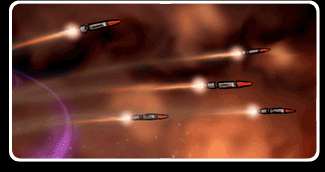 The Loroi Anti-Missile Missile is short-range hyper-velocity
missile used primarily to engage enemy torpedoes or fighters, but
which can
also be deployed against larger targets at very close
range (usually by fighters). There are many variants, ranging from 4-6m in length,
weighing 4-5 tons, capable of accelerations of 200-400g sustained for less
than 60 seconds. Most versions are kinetic-kill weapons that
require a collision with the target to do damage, and consist of
two stages: the main body contains the engine and fuel, and the
upper stage is a minimally-guided kinetic kill vehicle. In standoff
mode, the AMM can generate enough velocity through its own
acceleration to inflict significant kinetic damage to a target,
but against a maneuvering target it typically has an effective
range of less than 15,000km. As with any kinetic weapon, actual
damage done depends on the terminal velocity with the target
(which can be significantly altered due to velocity of either
the launching vessel or the target),
and such damage largely ignores defensive screens. The AMM can
be deadly from longer ranges against non-maneuvering targets
(such as asteroid bases), especially if given a velocity boost
by the firing craft. The round can also be set to retain its
boost stage for additional mass (and therefore increased damage)
in such a situation. There is also a cheaper single-stage
version (AMM-D) specifically designed for this kind of use, and
it is often carried in large numbers
by system assault forces for use against ground targets and
orbital assets.
The Loroi Anti-Missile Missile is short-range hyper-velocity
missile used primarily to engage enemy torpedoes or fighters, but
which can
also be deployed against larger targets at very close
range (usually by fighters). There are many variants, ranging from 4-6m in length,
weighing 4-5 tons, capable of accelerations of 200-400g sustained for less
than 60 seconds. Most versions are kinetic-kill weapons that
require a collision with the target to do damage, and consist of
two stages: the main body contains the engine and fuel, and the
upper stage is a minimally-guided kinetic kill vehicle. In standoff
mode, the AMM can generate enough velocity through its own
acceleration to inflict significant kinetic damage to a target,
but against a maneuvering target it typically has an effective
range of less than 15,000km. As with any kinetic weapon, actual
damage done depends on the terminal velocity with the target
(which can be significantly altered due to velocity of either
the launching vessel or the target),
and such damage largely ignores defensive screens. The AMM can
be deadly from longer ranges against non-maneuvering targets
(such as asteroid bases), especially if given a velocity boost
by the firing craft. The round can also be set to retain its
boost stage for additional mass (and therefore increased damage)
in such a situation. There is also a cheaper single-stage
version (AMM-D) specifically designed for this kind of use, and
it is often carried in large numbers
by system assault forces for use against ground targets and
orbital assets.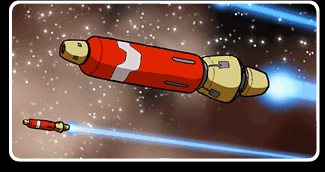 Torpedoes
are essentially small unmanned spacecraft with the same type of
powerplants and drives used in starships, and so can have
relatively high accelerations sustainable for longer periods,
allowing for potentially very long range. Also, the powerplant
of a torpedo doubles as its warhead (both fusion and
Type-A/taimat reactors can be induced to explode on demand), eliminating the need for a
separate payload. The drawbacks are that torpedoes are
relatively easy to destroy at range with beam weapons, and they
are comparatively expensive, making it very costly to use them in
numbers sufficient to saturate beam defenses. Also, because a
torpedo's fuel is also its payload, its potential damage output
is reduced the longer it has to maneuver. The major
combatants field a wide variety of torpedoes ranging from 4 to
46 meters in length and with typical accelerations from 40-60g,
depending on size and role. Torpedoes can be launched from
bases, warships, fighters, or as submunitions from larger
torpedoes. A torpedo will typically use its maneuvering
thrusters to achieve safe separation from the firing vessel
before lighting its main drive. A torpedo can cause kinetic damage if it can achieve
a collision, but often this will not be possible against a
maneuvering target, so it must make a ranged attack by
detonating its remaining fuel (which, in the case of the major
combatants, amounts to an antimatter explosion). An omnidirectional explosion has the potential to damage multiple
targets, but with a relatively small blast radius. Alternately,
the explosion can be used to direct a narrower jet of radiation
at the target increasing range but limiting the effect to a
single target. In either case, a hit from effective range can
have catastrophic effects against almost any target.
Torpedoes
are essentially small unmanned spacecraft with the same type of
powerplants and drives used in starships, and so can have
relatively high accelerations sustainable for longer periods,
allowing for potentially very long range. Also, the powerplant
of a torpedo doubles as its warhead (both fusion and
Type-A/taimat reactors can be induced to explode on demand), eliminating the need for a
separate payload. The drawbacks are that torpedoes are
relatively easy to destroy at range with beam weapons, and they
are comparatively expensive, making it very costly to use them in
numbers sufficient to saturate beam defenses. Also, because a
torpedo's fuel is also its payload, its potential damage output
is reduced the longer it has to maneuver. The major
combatants field a wide variety of torpedoes ranging from 4 to
46 meters in length and with typical accelerations from 40-60g,
depending on size and role. Torpedoes can be launched from
bases, warships, fighters, or as submunitions from larger
torpedoes. A torpedo will typically use its maneuvering
thrusters to achieve safe separation from the firing vessel
before lighting its main drive. A torpedo can cause kinetic damage if it can achieve
a collision, but often this will not be possible against a
maneuvering target, so it must make a ranged attack by
detonating its remaining fuel (which, in the case of the major
combatants, amounts to an antimatter explosion). An omnidirectional explosion has the potential to damage multiple
targets, but with a relatively small blast radius. Alternately,
the explosion can be used to direct a narrower jet of radiation
at the target increasing range but limiting the effect to a
single target. In either case, a hit from effective range can
have catastrophic effects against almost any target.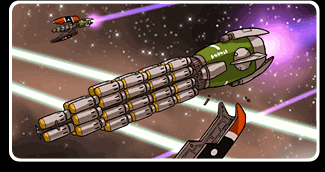 One strategy for addressing the vulnerability of torpedoes is
to package submunitions together in a larger torpedo that acts
as a protective blister. Similar in some ways to delivery by a
fighter, this allows for the possibility of launching numerous
high-acceleration missiles close to the target, at the potential
cost of having the whole package destroyed before it can deploy.
Even if the blister takes a hit, there is a chance it may still
be able to deploy some of its submunitions. Since unlike a fighter the blister is not reusable and is always
expended along with the submunitions, this is an expensive way
to deliver ordnance, but under the right circumstances can
increase the chance of a successful hit. Both sides employ a
variety of blister torpedoes.
One strategy for addressing the vulnerability of torpedoes is
to package submunitions together in a larger torpedo that acts
as a protective blister. Similar in some ways to delivery by a
fighter, this allows for the possibility of launching numerous
high-acceleration missiles close to the target, at the potential
cost of having the whole package destroyed before it can deploy.
Even if the blister takes a hit, there is a chance it may still
be able to deploy some of its submunitions. Since unlike a fighter the blister is not reusable and is always
expended along with the submunitions, this is an expensive way
to deliver ordnance, but under the right circumstances can
increase the chance of a successful hit. Both sides employ a
variety of blister torpedoes. 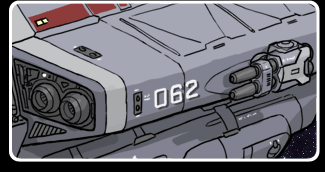 Also
known as
"railguns," "coilguns," or "gauss weapons," a
mass driver uses electromagnetic fields to fire projectiles with minimal guidance that rely
mostly on the launcher to give them velocity. Such a projectile
can do significant kinetic (or warhead) damage if it hits, but
since it will be ballistic during most of its flight, it has
very limited capability to hit a maneuvering target at any but
the closest of ranges. Mass drivers can be effective
against ground targets or space-borne targets that have no or
limited
ability to maneuver, but they are all but useless in the anti-ship role
except against vessels with very poor acceleration and very
short-ranged beam weapons (such as those still fielded by the more backward second-tier civilizations, including Humanity). Still, being
kinetic weapons, they can do great damage if a hit can be
achieved. Damage will be greatly affected by the
launching ship's velocity and the terminal velocity of the round
with the target, and
defensive screens will provide little protection. The damage
values below are based on Terran weapon mounts, but can represent any mass driver of the equivalent mass
and velocity, and the effective interception range assumes a
300m target with 30g acceleration capability.
Also
known as
"railguns," "coilguns," or "gauss weapons," a
mass driver uses electromagnetic fields to fire projectiles with minimal guidance that rely
mostly on the launcher to give them velocity. Such a projectile
can do significant kinetic (or warhead) damage if it hits, but
since it will be ballistic during most of its flight, it has
very limited capability to hit a maneuvering target at any but
the closest of ranges. Mass drivers can be effective
against ground targets or space-borne targets that have no or
limited
ability to maneuver, but they are all but useless in the anti-ship role
except against vessels with very poor acceleration and very
short-ranged beam weapons (such as those still fielded by the more backward second-tier civilizations, including Humanity). Still, being
kinetic weapons, they can do great damage if a hit can be
achieved. Damage will be greatly affected by the
launching ship's velocity and the terminal velocity of the round
with the target, and
defensive screens will provide little protection. The damage
values below are based on Terran weapon mounts, but can represent any mass driver of the equivalent mass
and velocity, and the effective interception range assumes a
300m target with 30g acceleration capability.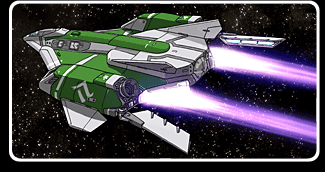 Fighters,
shuttlecraft, and other small in-system vehicles that are
usually carried by larger motherships are considered “Small
Craft.” Small craft do not have jump drives and are usually too
small to have inertial dampers, meaning that the crew and
passengers have limited protection against G stresses.
Consequently, the thrust of small craft must usually be limited
for passenger safety. Some combatants (notably the Loroi) use a
liquid breathing medium to allow their pilots to withstand very
high G forces. Small craft have limited endurance and must
normally dock with a mothership to refuel or rearm, and to be
carried from one star system to another.
Fighters,
shuttlecraft, and other small in-system vehicles that are
usually carried by larger motherships are considered “Small
Craft.” Small craft do not have jump drives and are usually too
small to have inertial dampers, meaning that the crew and
passengers have limited protection against G stresses.
Consequently, the thrust of small craft must usually be limited
for passenger safety. Some combatants (notably the Loroi) use a
liquid breathing medium to allow their pilots to withstand very
high G forces. Small craft have limited endurance and must
normally dock with a mothership to refuel or rearm, and to be
carried from one star system to another.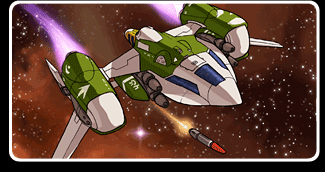 Small
craft can also be used in direct combat roles, provided that the
pilots can be protected from the 30+ g accelerations
required. In their early years of empire, armed craft were an
important offensive weapon for the Loroi, and many vessels of
cruiser size or larger carried fighters in addition to
conventional weapons. The Loroi still field a variety of
specialized fighters, but in the current war against such a
numerous opponent, Loroi fighters are less effective on offense
and are used mainly to supplement fleet defense against Umiak
torpedoes and gunboats. The Umiak themselves do not use manned
fighter-class craft, as their acceleration intolerance makes
them unsuitable fighter pilots; instead, they use larger
gunboats (see below). Loroi fighters use missiles (both
torpedoes and AMM) in the offensive role, and are armed with
lasers for defense. In addition to internal weapons, armed craft can mount
modular weapons on external ordnance pylons. Each Loroi fighter
hardpoint can mount a single short-range torpedo, a rack of 3 or
6 AMM missiles, 3 USR torpedoes, or a specialty ordnance
module.
Small
craft can also be used in direct combat roles, provided that the
pilots can be protected from the 30+ g accelerations
required. In their early years of empire, armed craft were an
important offensive weapon for the Loroi, and many vessels of
cruiser size or larger carried fighters in addition to
conventional weapons. The Loroi still field a variety of
specialized fighters, but in the current war against such a
numerous opponent, Loroi fighters are less effective on offense
and are used mainly to supplement fleet defense against Umiak
torpedoes and gunboats. The Umiak themselves do not use manned
fighter-class craft, as their acceleration intolerance makes
them unsuitable fighter pilots; instead, they use larger
gunboats (see below). Loroi fighters use missiles (both
torpedoes and AMM) in the offensive role, and are armed with
lasers for defense. In addition to internal weapons, armed craft can mount
modular weapons on external ordnance pylons. Each Loroi fighter
hardpoint can mount a single short-range torpedo, a rack of 3 or
6 AMM missiles, 3 USR torpedoes, or a specialty ordnance
module.